Where to Stay in Olympic National Park: A Complete Guide
Olympic National Park is situated at the northwest corner of the contiguous United States, and is the most diverse national park in the Pacific Northwest. And, to be honest, it’s not that close.
Within the boundaries of the park, you’ll find crystal-clear alpine lakes backed by snowy peaks, rocky beaches being pounded by the intense Pacific surf, one of the best examples of a coastal temperate rainforest in the country, and some of the most stunning waterfalls in Washington State.
However, speaking as people who have planned trips to Olympic National Park ourselves, we’re intimately aware of how confusing it can be to make sense of the park, which is spread over 1,400 square miles that aren’t actually always connected to each other.
In this guide, we’re going to give you all the information you need to figure out the best place (or, places, as we’ll get to in a second) to stay in Olympic National Park for your trip.
We’ll go through a geography overview of the park’s regions up front to help you visualize the park’s layout, take you through our high-level recommendation on how to approach finding a place to stay, then we’ll go through our recommendations in terms of places to stay in each of the park’s regions.
Our intention is that, by the end of this guide, you’ll have all the information you need to decide on the best place to stay in Olympic National Park based on your particular trip, style, and budget.
Sound good to you? Let’s get into it.
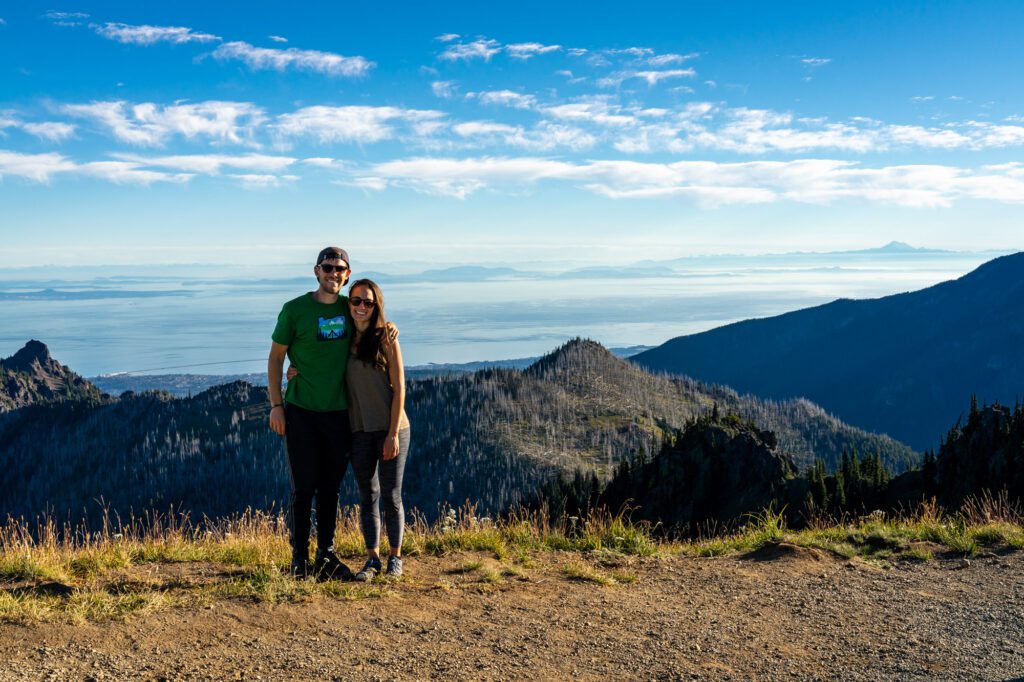
Disclaimer: Some of the links in this post, like hotel links, are affiliate links, meaning at no additional cost to you, we make a little bit of money if you click through and book. That being said, we would never recommend something to you that we don’t stand behind 100%.
Planning to visit Olympic National Park? We’ve got more detailed travel guides to help you explore Olympic National Park and make the most of your time in the northwest corner of Washington State.
- How to Plan an Amazing Olympic National Park Itinerary
- The Best Hikes in Olympic National Park
- 17 Unforgettable Things to Do in Olympic National Park
- The Best Time to Visit Olympic National Park: All 4 Seasons (COMING SOON)
A Quick Olympic National Park Geography Overview
Before we get into the specific places to stay below, we really need to take a second to talk about the park’s geography up front.
Because, in the case of Olympic National Park – which covers 1,400 square miles in northwest Washington State – it definitely matters. Especially considering the park is fragmented, with non-park land cutting in and out of the park’s boundaries.
Olympic National Park is a land of contrasts, and while that’s a bit of a cliche, we think it fits the bill here.
Within those 1,400 square miles, you have the rocky beaches and towering sea stacks of the Pacific Coast, the alpine regions of the park centered around Hurricane Ridge, some of the best examples of coastal temperate rainforests in the world, and dense evergreen forests as far as the eye can see.
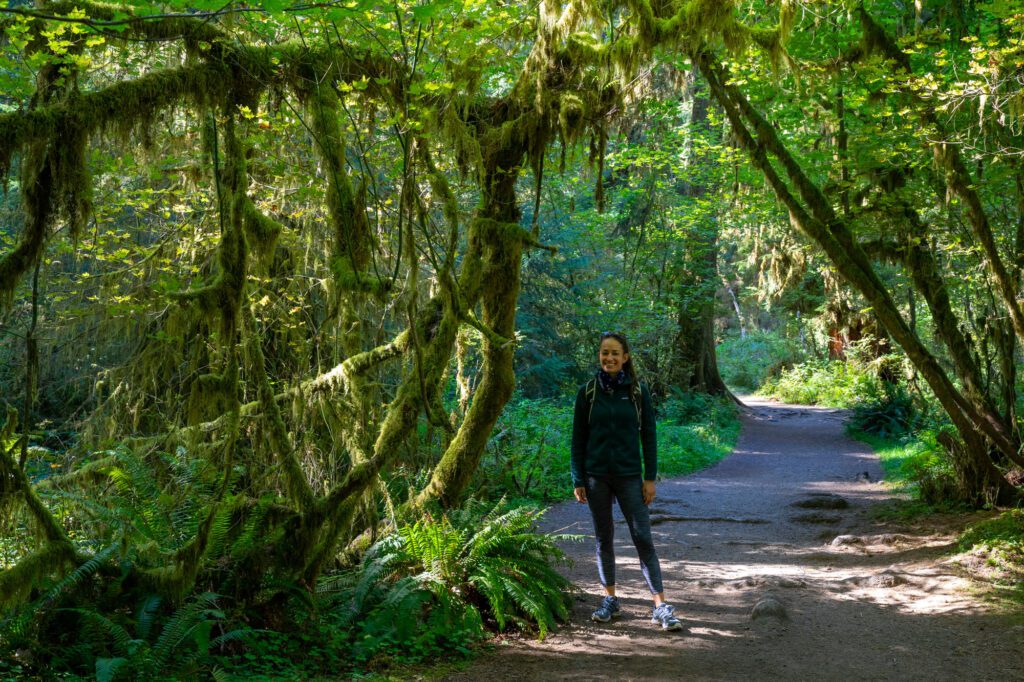
To make it more easily digestible, we’re going to break the park up into regions, and use those to talk about where to stay for your visit to the Olympic Peninsula.
After we go through those regions, we’ll talk about the best approach to planning your trip to make sure you aren’t driving more than you need to.
At a high level, we like to think of Olympic National Park as having five distinct regions.
They are:
- Hurricane Ridge: The alpine region of the park, this is where you’ll gain some elevation to get up to 5,200 feet above sea level. That climb means you’ll have incredible views out over the surrounding landscape including the snowy peaks of the Olympic Mountains and Mount Baker, and across the Canadian border to Victoria. There are no places to stay up here other than one campground and some backcountry camping, so you’ll want to stay in Port Angeles or around Lake Sutherland.
- Lake Crescent and the Sol Duc Valley: As you head west out of Port Angeles, you’ll enter the Elwha Valley and pretty quickly you’ll reach the shores of Lake Crescent, the most popular lake in the park. This is a lush area of evergreen forests and waterfalls, which is a bit of a contrast to both Hurricane Ridge and the rugged Pacific Coast. Port Angeles or Lake Sutherland are, once again, the best place to stay for access to this area.
- The Central Pacific Coast: The heart of the Pacific Coast runs from the coastal community of La Push down to Kalaloch, and is lined with countless beaches. The best, in our opinions, are Rialto (don’t miss the beach hike out to Hole in the Wall!), Second Beach, and Ruby Beach. The best place to stay to explore this section of the Pacific Coast is going to be in and around Forks (yep, THAT Forks).
- The Northern Pacific Coast: The more rugged and harder to reach piece of the Pacific Coast is at both the northwestern corner of Washington State and the contiguous United States. If you’re up for a bit of a journey, you can get all the way out to Cape Flattery, which is the northwest corner of the country. Shi Shi beach, though, is the highlight here. The best way to access this more remote part of the park is going to involve a long drive no matter which way you slice it. We’d do it on the way from Port Angeles to Forks (or vice versa).
- The Coastal Temperate Rainforests: Located in the southwestern corner of the park, the Hoh Rainforest is the most famous example of this natural phenomenon that thrives in the Pacific Northwest thanks to all the moisture and precipitation. Ferns in a shade of green you didn’t know existed, mosses that look like they belong in Lord of the Rings, and a herd of Roosevelt elk make this a special place. The Quinault Rainforest is further south, and is another worthwhile stop (though not as impressive in our minds).
Here’s a map to help you visualize what we’re talking about here.
Our Recommended Approach for Olympic National Park
Now that we’ve briefly covered the geography, let’s get into figuring out exactly where to stay. We need to start with our recommended approach.
The first thing to know is that it takes a LONG time to drive between certain regions. For example, the drive between Hurricane Ridge and Forks – the two most popular parts of the park – takes one hour and 45 minutes one way. So, if you stay in one of those places for your entire trip, you’d be driving nearly four hours to get to the other one.
The best place to stay to explore Hurricane Ridge and Lake Crescent / the Sol Duc Valley is either Port Angeles (if you want more of a city vibe) or Lake Sutherland (if you want more of a nature vibe).
The best place to stay to explore the Pacific Coast and the coastal rainforests is Forks, or the area nearby.
For that reason, we’d strongly, strongly recommend splitting your time between the Port Angeles / Lake Crescent area, and the Forks area. And we’d split it roughly right down the middle (if you have an odd number of nights, we’d probably choose to spend the extra night in Forks over Port Angeles, but it’s close to a toss up).
Yes, that means you’re going to be moving around a little more than we usually like, but we think the time saved is worth the hassle of checking in and out more than once.
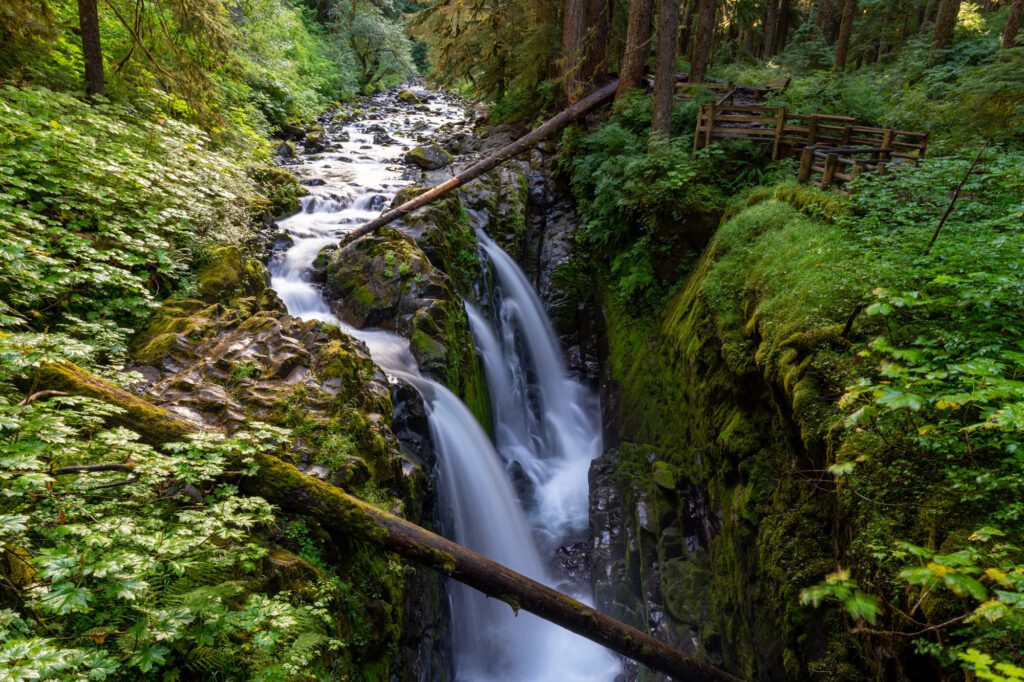
Where to Stay in Olympic National Park: A Complete Guide to the Best Places to Stay
And now, let’s get to the best places to stay in Olympic National Park in detail. We’ll cover three regions – Port Angeles, Lake Sutherland, and Forks – before going into a brief overview of camping in the park.
One important note: As we covered in depth above, Olympic National Park is ENORMOUS. It’s going to make your life a lot easier if, rather than staying in one place to explore the entire park, you move around a bit. For most people, that means staying in Port Angeles / Lake Crescent for a couple of nights to get to Hurricane Ridge and Lake Crescent, and then staying in Forks for a night or two to explore the Pacific Beaches and Hoh Rainforest.
Now, we’re well aware that a few of you are currently ready to throw your left shoe at the screen, saying “I don’t have time to read all of that, JUST TELL ME THE BEST PLACE TO STAY!”
Well, here’s a quick summary of this guide if you’re short on time (though we’d recommend reading the section of the place you end up staying for tips and places to add to your list!).
- The most convenient place to stay for Lake Crescent and Hurricane Ridge is either Port Angeles (for a city vibe with more amenities like restaurants and grocery stores) or around Lake Sutherland (for lakefront living and a more rural vibe). In Port Angeles, stay at the Olympic Lodge, which is the best option in town. Around Lake Sutherland, go with either the Emerald Valley Inn (we’ve camped there, but they have great hotel-style rooms too) or a cabin on the shores of Lake Sutherland. If you’re camping, Heart O’ the Hills Campground (first come first served) and Sol Duc Campground (we’ve stayed there, reservations required) are the best options.
- For the Pacific Coast and Hoh Rainforest, you’re going to want to stay in and around Forks. Choose between the Woodland Inns, which is a set of new cabins (which have kitchens) right in the heart of town, or the Misty Valley Inn, which is a bed and breakfast just north of town in a quieter location. I’m planning a trip up to Olympic in 2023, and have a couple of nights booked at the Hoh Valley Cabins, which look like a tranquil place to spend a few nights (though the location is slightly less convenient for the coast). If you’re camping, Mora Campground is the best option here (we’ve stayed there multiple times now).
Port Angeles: The Best Place to Stay for Hurricane Ridge if You Want to Be in a City
Port Angeles is the biggest city on the border of Olympic National Park, which makes it a good home base if you’re looking to be close to amenities like gas, restaurants, and grocery stores.
Once you get out into the park, the options for those things start to get few and far between (read: nonexistent until you get to Forks).
The Best Places to Stay in and Around Port Angeles
There is a nice selection of hotels and vacation rentals in and just outside the city center.
If you want to camp, the best option is going to be Heart O’ the Hills Campground, which is a little ways up the hill to Hurricane Ridge. It’s first-come, first-served, so don’t expect to get a spot if you show up at 5:00 pm on a Friday night during the summer.
Olympic Lodge
If you’re looking for a comfortable place to stay in Port Angeles, the Olympic Lodge is probably your best bet. It’s the best hotel in town.
The floor-to-ceiling windows in the lobby bring in all of the natural light, even on the grayest of days (it’s the Pacific Northwest, so it’s sometimes a little dreary). Parking is included in the room rate, as are the outdoor heated pool and hot tub onsite.
The lodge rooms here are not the most hip and up-to-date, but they have everything you need for a couple of nights of exploring. They have a couple of configurations – two queens and one king are the most common – and some rooms have views of the water, while others have a view of the golf course behind the lodge and the Olympic Range beyond.
Some rooms are pet-friendly too, though you should know that pets aren’t allowed in Olympic National Park (except for parking lots, basically).
Hidden Haven Cottages
This small resort with five cozy cottages is 15 minutes west of Port Angeles, which is a great location for both Lake Crescent and Hurricane Ridge.
The resort itself is beautiful, with perfect landscaping that dates way back to 1976, when the owners first set out to create an idyllic getaway. This will likely be a place where you get more personalized service since there are only five cottages onsite.
It definitely skews towards couples and the romantic side of the spectrum, which is something to know before you book.
All five cottages are one bedroom, jacuzzi tubs (one of them is heart-shaped), private decks (or patios), and have full kitchens.
No pets allowed, unfortunately.
The Sun House at Freshwater Bay
2 bedrooms (+ sofa bed) / 1 bathroom
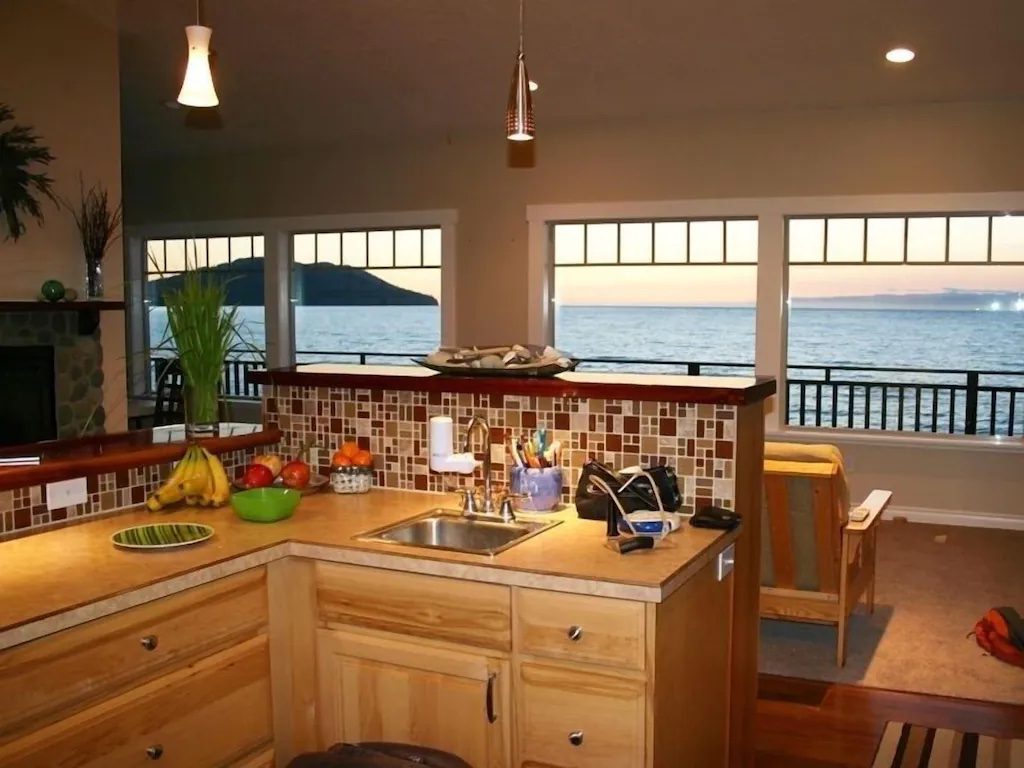
If you’re looking for a truly waterfront stay, where you’ll be able to watch the sun set from the kitchen, this coastal getaway is a great option.
It’s a 15 minute drive outside of Port Angeles on the northern coast of Washington, situated along the Strait of Juan de Fuca.
Is it the most modern and up to date place to stay? No, probably not. But you’re here for the location right on the beach.
Two bedrooms – one of which has a great view out over the water – and a wraparound deck make this an excellent home base for the northeastern part of the park.
Pets allowed, there’s a maximum of 50 pounds.
Two Bedroom House with Views of the Strait of Juan de Fuca
2 bedrooms (+ sofa bed) / 2 bathrooms
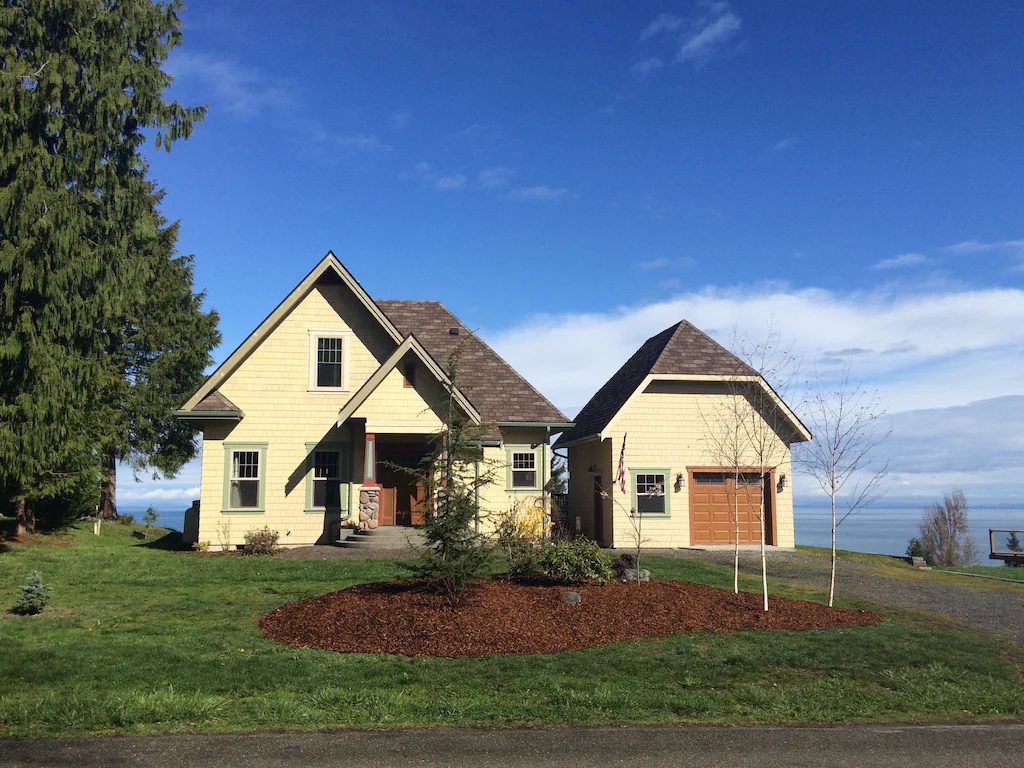
This standalone house is located just east of Port Angeles, about a 15 minute drive from the city center (which adds a little bit of travel time to your trips to Hurricane Ridge and Lake Crescent).
It also has great water views, though it’s not actually right on the water. It is, however, more modern – it was built in 2015 and has modern appliances (that gas stove is dreamy). Imagine sitting on that deck, watching the sun set over the Strait of Juan de Fuca.
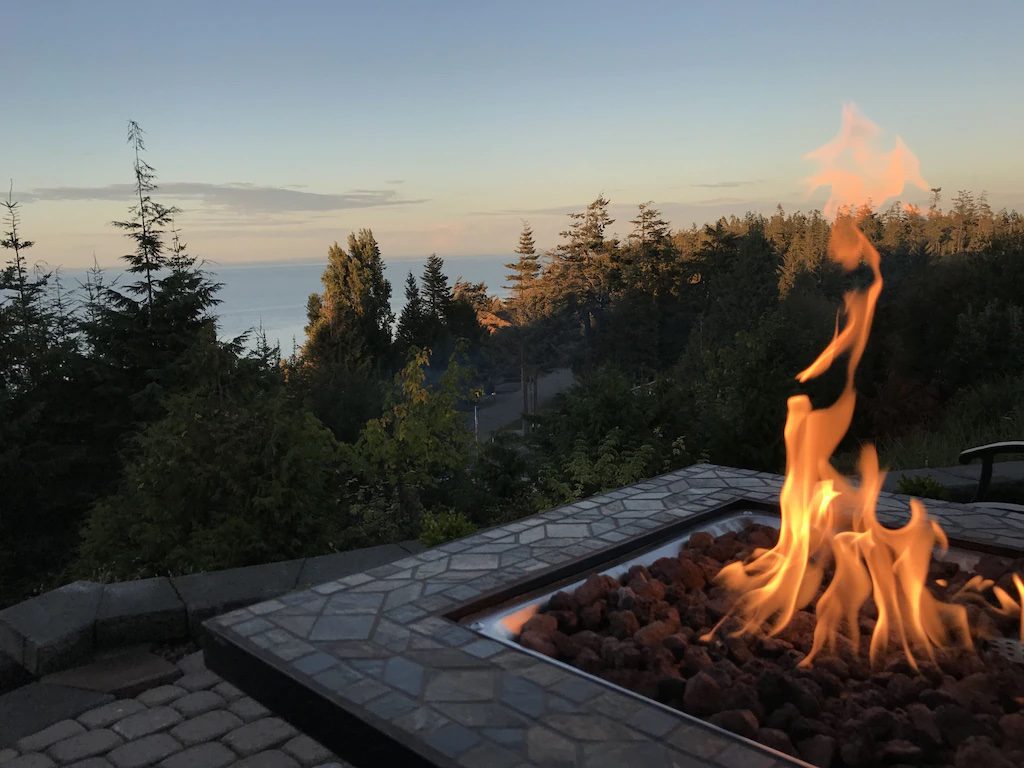
In the colder months, there are a couple of fireplaces inside, and a gas fire pit outside.
No pets allowed, and there’s a maximum of five guests.
A Rustic Cabin Getaway On the Strait of Juan de Fuca
1 bedroom / 1 bathroom
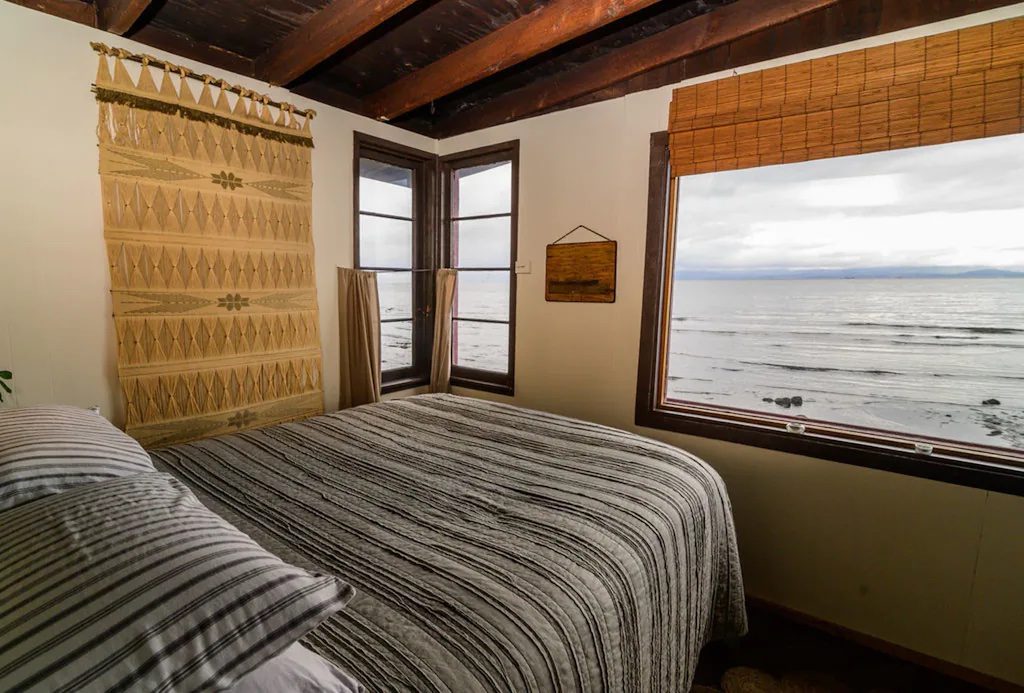
Imagine staying in a rustic cabin that’s sitting right on the beach in Port Angeles. With ocean views from the comfort and warmth of your cozy bed. This cabin doesn’t have electricity, but it does run all appliances on propane.
Also, if you enjoy a nice and cozy wood-burning stove for those chilly evenings, then you’re in luck because this cabin has one.
Plus, it’s LITERALLY right on the water.
That place booked? The host has two other listings nearby, which are essentially the same:
A Unique Treehouse in Port Angeles
1 bedroom / 1 bathroom
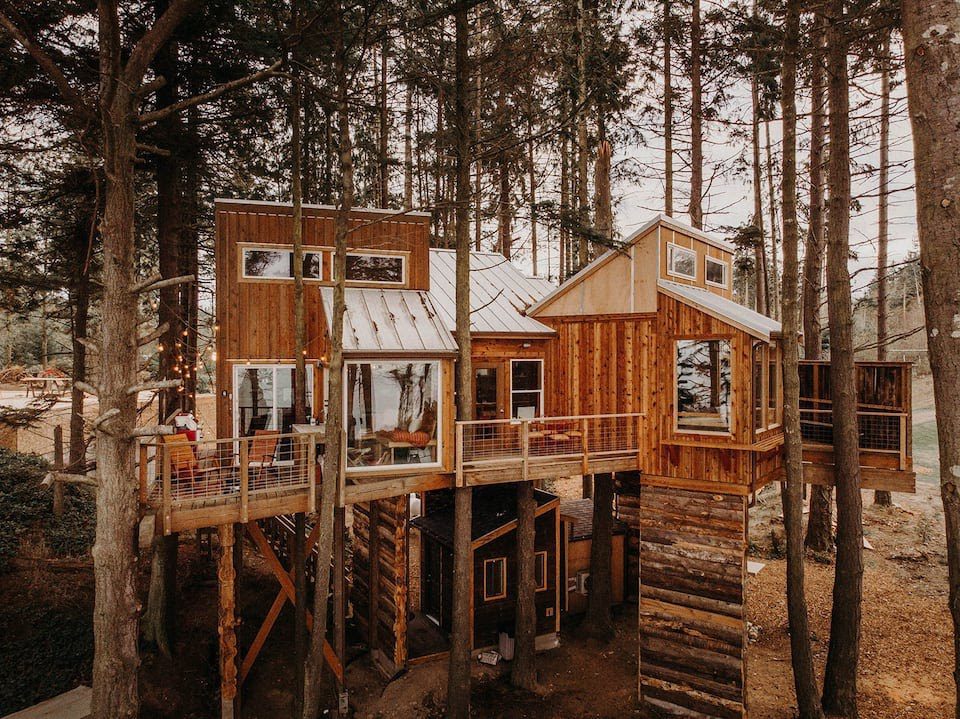
A tree house? Sign me up! This gorgeous treehouse property has views of the Strait of Juan de Fuca from the living room, along with a kitchen and a shared firepit that overlooks the ocean.
This is a super unique stay on the Olympic Peninsula, and makes a great rustic weekend getaway from Seattle.
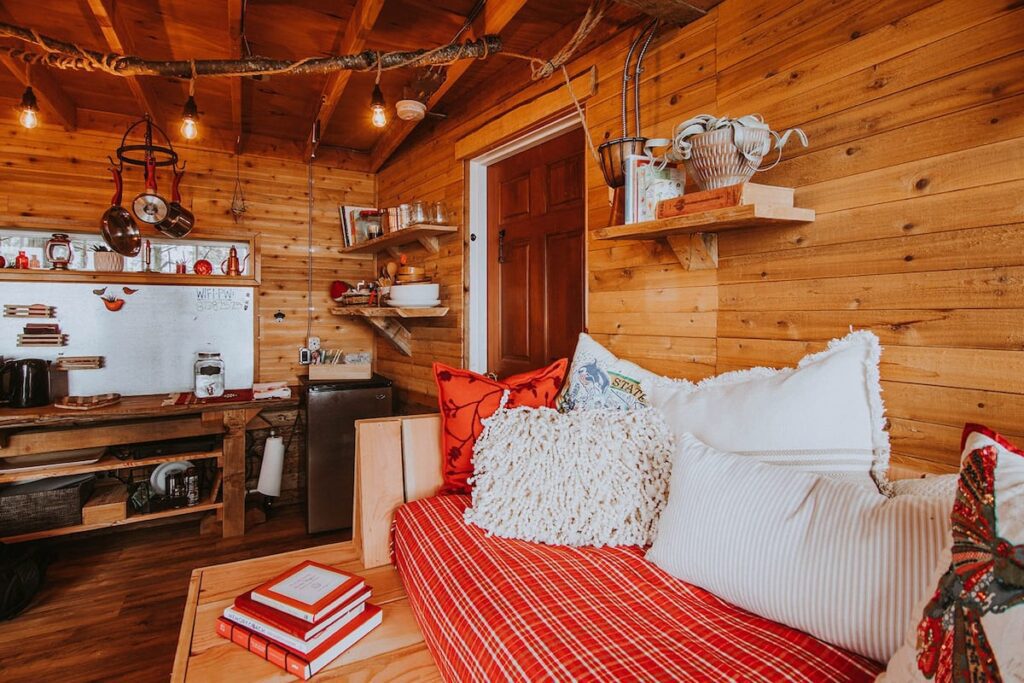
It’s worth noting that it’s about 45 minutes away from Lake Crescent and Hurricane Ridge, which is plenty close for a day trip to either location.
Still, this property is worth the drive, we think.
Lake Sutherland: The Best Place to Stay for Hurricane Ridge if You Want to Be Outside the City
Lake Sutherland is right along Highway 101, between Port Angeles and Lake Crescent. We’re calling this area Lake Sutherland, but we’re really talking about the entire stretch from Port Angeles into the Sol Duc Valley.
It’s more rural – there are no restaurants, grocery stores, or gas stations here – but you’ll be able to immerse yourself in the natural beauty while you stay here.
Choose between a cabin on the shores of Lake Sutherland, which are a good blend of modern amenities and beautiful location, or a more rustic stay nearby.
The Best Places to Stay in and Around Lake Sutherland
There are essentially two options here – a cabin on Lake Sutherland (Lake Crescent’s smaller cousin, about five minutes east), or one of the inns or cabins in the area to the north and east of Lake Crescent.
If you want to camp, the best bet here is Fairholme Campground, which is on the western shore of Lake Crescent and is reservable in advance during the summer here.
There’s also Sol Duc Campground, which you need to reserve in advance here. We’ve stayed there and it’s nice enough, but it’s a 15-20 minute drive up the road which adds travel time.
Lakefront Home with All the Amenities
3 bedrooms / 4 bathrooms (sleeps 8)
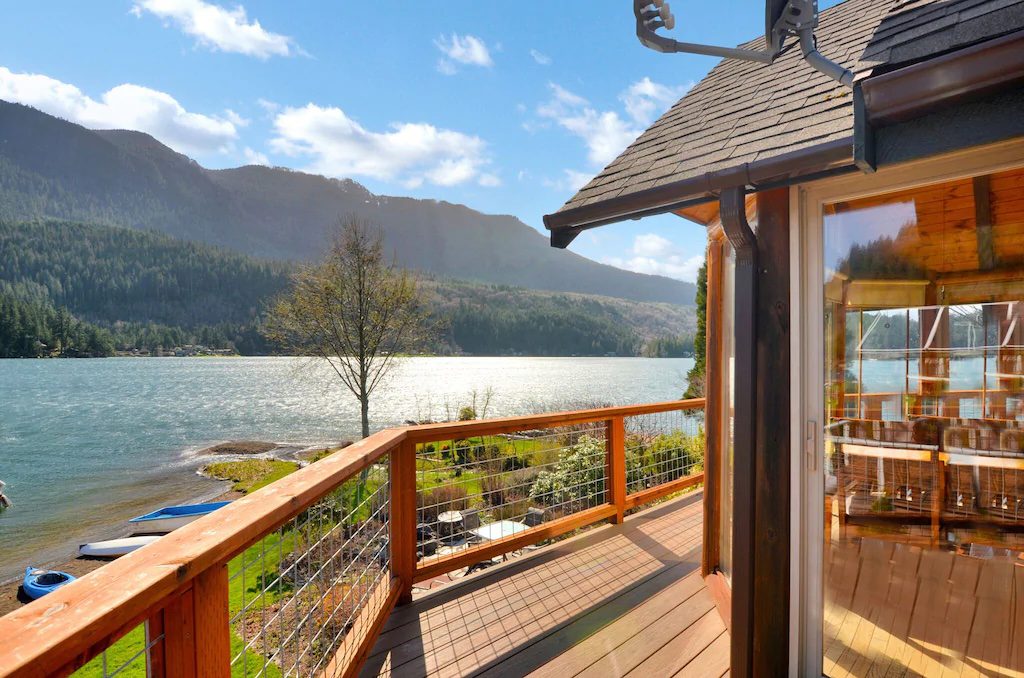
I mean, a scroll through the pictures of this beautiful lakefront house will tell you everything you need to know.
It’s spacious, it’s full of natural light, it’s on the lake, and the deck and dock out back is amazing. We love the vaulted ceilings in the living area and the wood tones throughout.
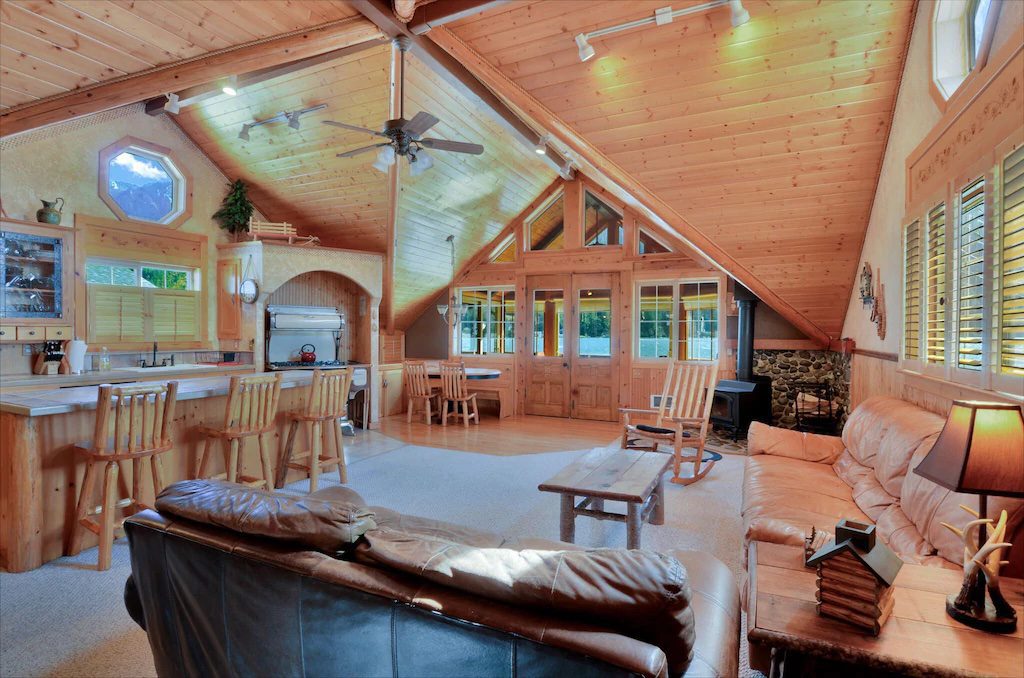
They also have kayaks, a rowboat, and some paddleboards for you to take out on the lake, which is an excellent amenity for the summertime. In the winter, you’ll love the wood burning stove.
If you have a bigger group – there are three bedrooms here – this would be a great home base for exploring the north and eastern parts of Olympic National Park.
Gateway to Olympic National Park on the Shore of Lake Sutherland
2 bedrooms / 1 bathroom (sleeps 4-6)
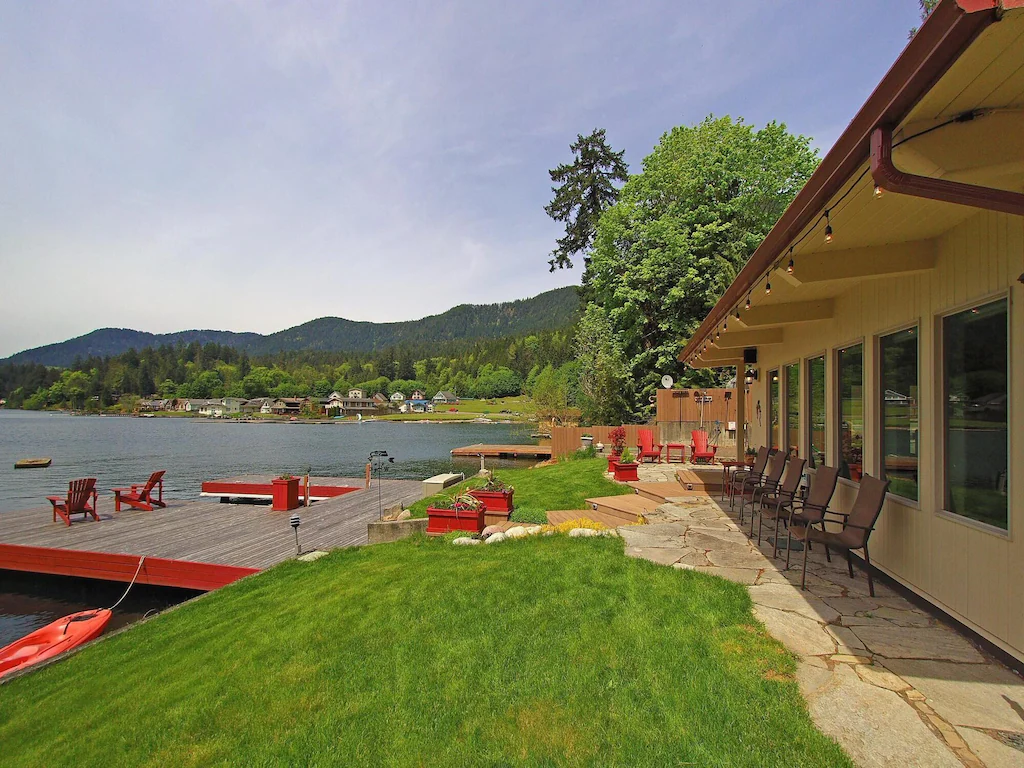
This lakefront home is on the sunnier side of the lake (according to the owners), and is right off of 101, putting you about 5 minutes from the visitor center at Lake Crescent (not to mention the trailheads for the hikes that leave from the lake, like Marymere Falls and Mount Storm King).
The house has a deck, a barbecue, a modern kitchen stocked with everything you need to cook meals for yourself, and a great view of the lake.
There are two full bedrooms, plus a murphy bed that folds out to bring the capacity up to 4-6 guests.
The Emerald Valley Inn
The Emerald Valley Inn is a couple of minutes east of Lake Sutherland, between Lake Crescent (~10 minute drive) and Port Angeles (~15 minute drive). It’s also right on Highway 101, the main route through the park, which is nice.
We know of it because, in the summertime, they open the field in the back to campers, and we spent a couple of nights back there with friends. It’s… just a field, so we’d recommend camping elsewhere if you have the choice. The inn itself is nice and, crucially, affordable.
They have a mix of basic hotel-style rooms and bigger suites (with more room, a fridge, and a microwave).
It’s a good value for the location, and the restaurant out front – Granny’s Cafe – is fun (particularly for the soft serve in the summer).
Sol Duc Serenity
1 bedroom / 1 bathroom (sleeps 2-4)
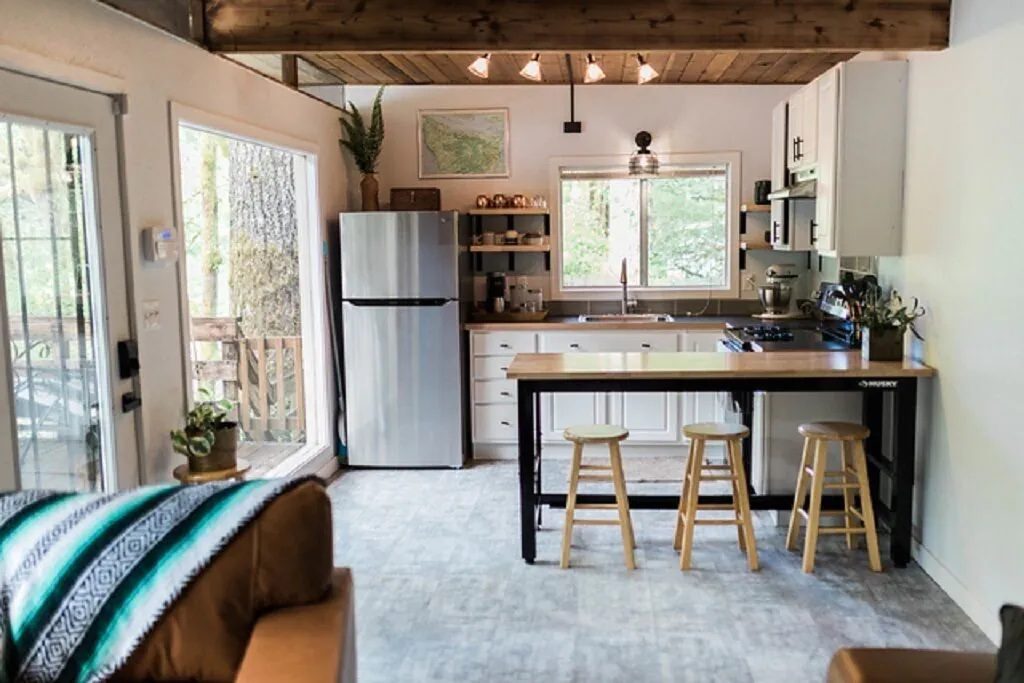
This cozy cabin – which is gorgeous, by the way – is on the other side of Lake Crescent, about a 20 minute drive west of the lake. Which is definitely further from Hurricane Ridge, but is actually a better location for visiting places like Sol Duc Falls and Lake Crescent when you compare it to Port Angeles.
It’s right along the Sol Duc River, and there’s a riverfront hot tub out back that would be perfect for a soak after a day of exploring.
It’s very stylish and modern, with a nice full kitchen, a living room with big windows, and a modern bathroom. There are two decks (one with the aforementioned riverfront hot tub), plus a firepit in the backyard.
It claims to sleep four, with a sofa bed in the living room, but it seems to us that it would be VERY tight. Better for couples or groups of 2, we think.
A modern riverfront stay in a great location – what’s not to love?
Forks: The Best Place to Stay for the Pacific Coast and Coastal Rainforests (Yes, THAT Forks)
Forks is the main city on the stretch of Washington coast that runs through Olympic National Park. This is one of the weird parts about the park – the city of Forks is technically not inside the park, but the coastline nearby is part of the park.
While Forks has always been on the map for visitors to Olympic National Park, it really got famous in the 2000’s when it was the main setting for the movie Twilight. Today, there’s a small Twilight Museum, but that’s the only thing that remains from all the hype it got a decade ago.
Forks is a great home base for exploring the Pacific Coast and the Hoh Rainforest, both of which are within 30-45 minutes. There’s a grocery store, a gas station, a couple of restaurants, and a handful of hotels in town, but not much else.
The Best Places to Stay near Forks
There are two options here – staying in the town of Forks itself, which has a couple of good hotel options, or staying outside of town in a more rustic setting.
If you want to camp here, we’d highly recommend Mora Campground which is out near Rialto Beach. We’ve camped there a few times now, and it has been great every single time. Reservations need to be made in advance here.
The Woodland Inns
A newer option in Forks, this is a collection of spacious cabins in the heart of the city.
They’re relatively spacious compared to a normal hotel room, and crucially have full kitchens. We’re not saying that the restaurant options in Forks are terrible (Matt has Celiac Disease, and there are exactly zero gluten free options here), but they’re not the best.
They have a collection of nine standard cabins, all of which have a full kitchen and fireplace. They’re all studio-style, which means it’s all one space, but they have configurations with two queen beds or one queen bed.
They also have deluxe cabins, which are a one bedroom layout with a separate sleeping space from the living room and kitchen.
No pets allowed here. Which, again, makes sense since there are no pets allowed in the national park anyway.
The Pacific Inn Motel
The Pacific Inn Motel is a basic hotel in the middle of Forks (literally on 101, which runs right through town). It doesn’t necessarily have all the bells and whistles (like full kitchens and fancy fireplaces) of the Woodland Inns, but it does come at a more affordable price.
Rooms are basic and comfortable, and they come in a couple of different configurations: one king, one queen, two queens.
No breakfast, no frills, but the price and location are good. Remember – staying here means you’ll be eating out in Forks since the rooms don’t have kitchen facilities.
The Misty Valley Inn
This charming bed and breakfast is a unique stay just outside of Forks.
And it is a bed and breakfast, which to us means that you get a nice breakfast included in your stay. Here, you’ll get a range of freshly made breakfast options from pancakes to biscuits and gravy to fuel you up before a day of exploring.
Rooms here are going to be relatively compact – it’s really just a bed and bathroom – but it’s very quiet so you’ll be able to get a good night’s rest. There are some communal spaces, like outdoor decks and the indoor dining room (which is where breakfast is served), but you won’t have a whole lot of space to spread out and relax.
If you decide to stay here, you can expect good service, a hearty breakfast, and a quiet place to sleep just outside of Forks.
Hoh Valley Cabins
The location of these cozy cabins isn’t as good as the other places on this list in the sense that it’s a little further from the beaches and the coast (about 20-30 minutes away).
However, I’m planning a spring trip to Olympic National Park right now, and I’m going to book a couple of nights here because I love the location in the rainforest.
While you’ll be further from the coast, you’ll be closer to the Hoh Rainforest, which will benefit you because the road out there gets closed when the parking lots fill up in the summer, and you’ll have a 20-30 minute head start to beat the crowds because you’re halfway there.
The four cabins themselves are relatively new, and have modern appliances and a one bedroom layout. They all have queen beds, full kitchens, and nice fireplaces.
The Historic National Park Lodges: Good Locations, Bad Value
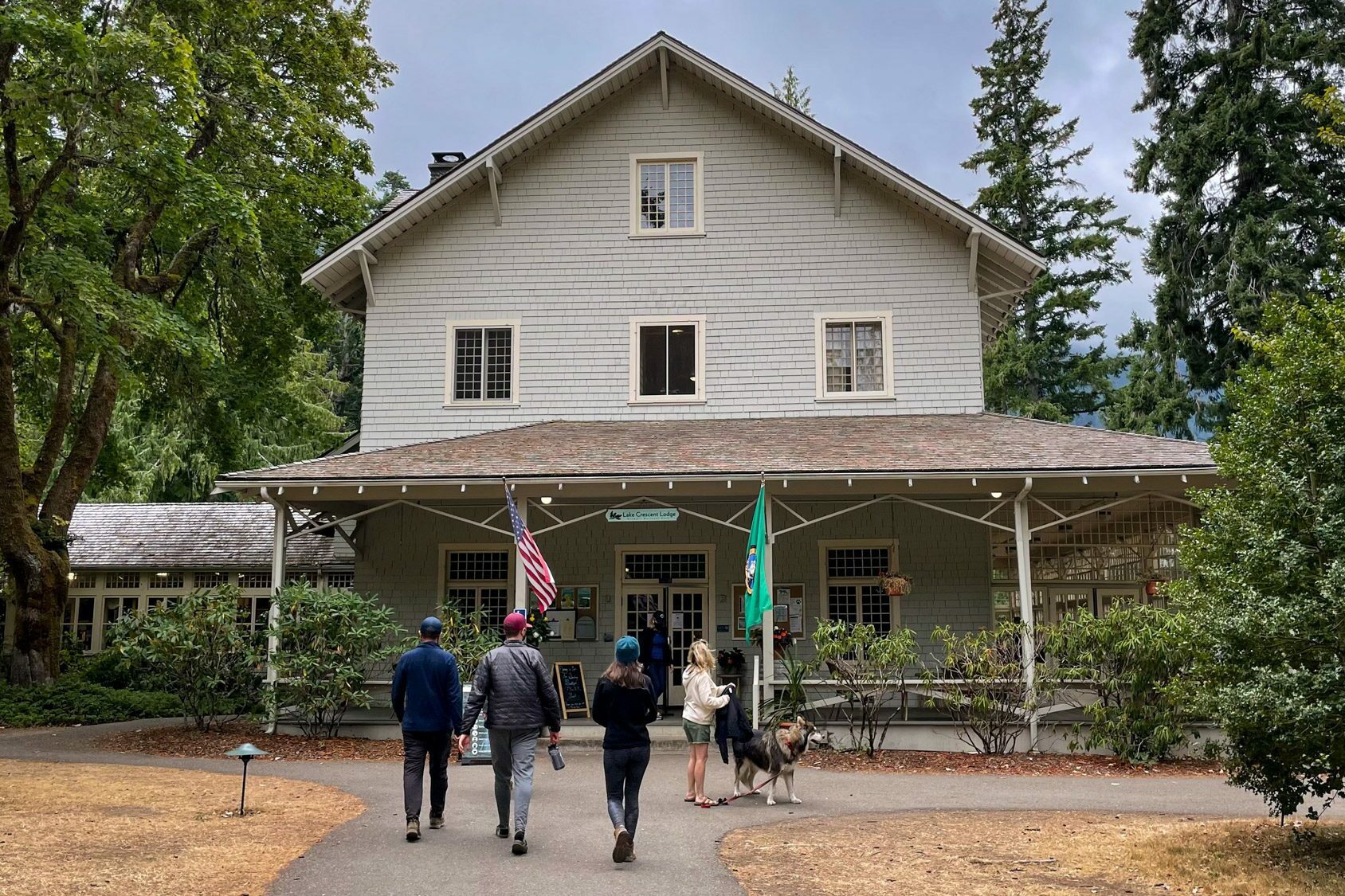
You can’t really cover the best places to stay in Olympic National Park without talking about the historic national park lodges. They’re rustic and charming, and are definitely worth a visit if you find yourself nearby.
However, as we’ve covered in other national parks posts, they’re usually not a great place to stay. While the location inside the park is bound to be phenomenal, the price and facilities are almost always going to leave something to be desired.
And, when you think about it, it kind of makes sense.
These lodges are at full capacity for most of the year – that’s why they’re so hard to book – which means there’s not a whole lot of time for renovations. Then, consider who’s doing the renovating, and where that money is coming from. There are more pressing issues in national parks than whether the carpet or tile needs to be replaced in one of the lodges.
So, while they’re fun to visit, we wouldn’t recommend staying in one of them. You’ll pay more than it’s worth, you’ll have a hard time getting a reservation in the first place, and you’re bound to be disappointed by the facilities (for example, paying for WiFi – what is this, 1997?).
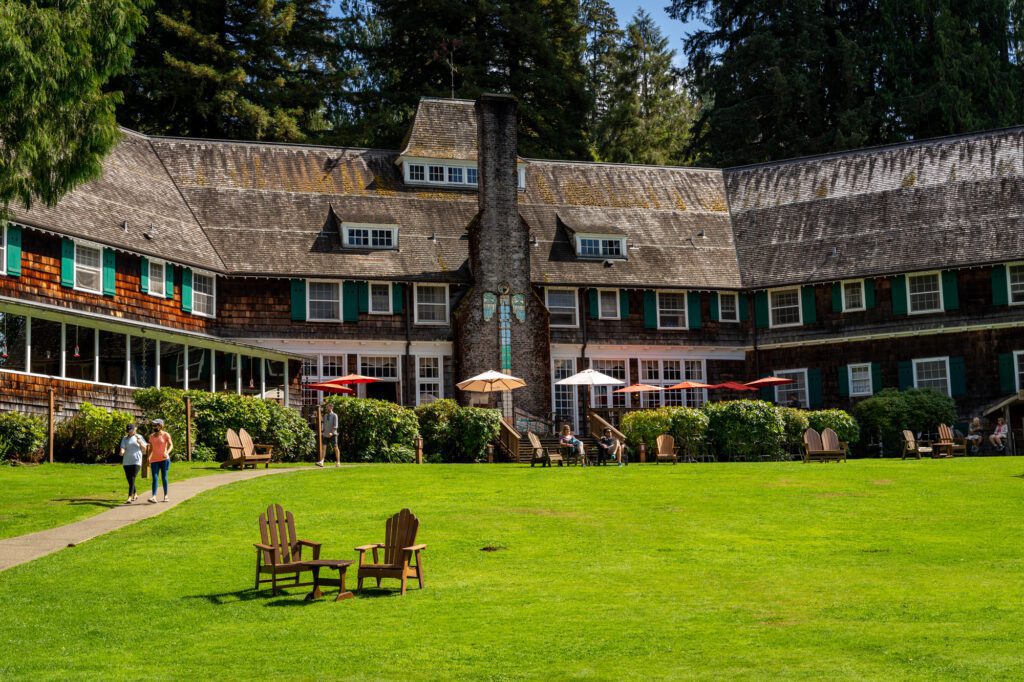
With all that being said, the allure of the rustic charm and great location of one of these lodges might be a draw for you.
Here are the national park lodges in Olympic National Park.
- Lake Crescent Lodge: The best of the bunch here because of the great location on the shores of Lake Crescent, this is the only one we’d even consider staying at. They have a combination of historic lodge rooms and rustic cabins (that are on the lakeshore). Crucially, none have kitchens, so you’ll be eating at the (expensive) onsite restaurant because there are no other options within 30 minutes. Open from the end of April through the end of the year. More information here.
- Lake Quinault Lodge: Again, a very cool place to visit if you find yourself down south exploring the Quinault Rainforest. But we probably wouldn’t choose to stay here. It was built in 1926, and there are a variety of rooms here to choose from, including rooms in the boathouse annex. They’re open year round. More information here.
- Log Cabin Resort: Unlike Lake Crescent Lodge, which is along Highway 101 on the lake’s south shore, this place is even more rustic. It’s up on the north shore of the lake, which is far less visited. One thing I will say is that they have cabins with full kitchens here, which is great because there are really no dining options nearby. Open late May through November. More information here.
- Sol Duc Hot Springs Resort: Located up Sol Duc Road towards the trailhead for Sol Duc Falls, this resort is part historic lodge, part hot springs. They have a couple of different cabin types – some of them have kitchens – right along the Sol Duc River. There are hot spring pools here, though they’re basically a hot tub, just heated naturally thanks to geothermal activity. Plus, they’re very crowded. More information here.
- Kalaloch Lodge: Kalaloch Lodge is probably the nicest of all the options here, but it’s also in the worst location, at the southwestern corner of the park. It’s not really that close to any of the main highlights of the park, except for the Kalaloch beaches and Ruby Beach. Still, we actually like the cabins with kitchens (though you’ll need to bring your own utensils, pans, etc etc). They also have a few pet-friendly cabins. Book here.
Camping in Olympic National Park
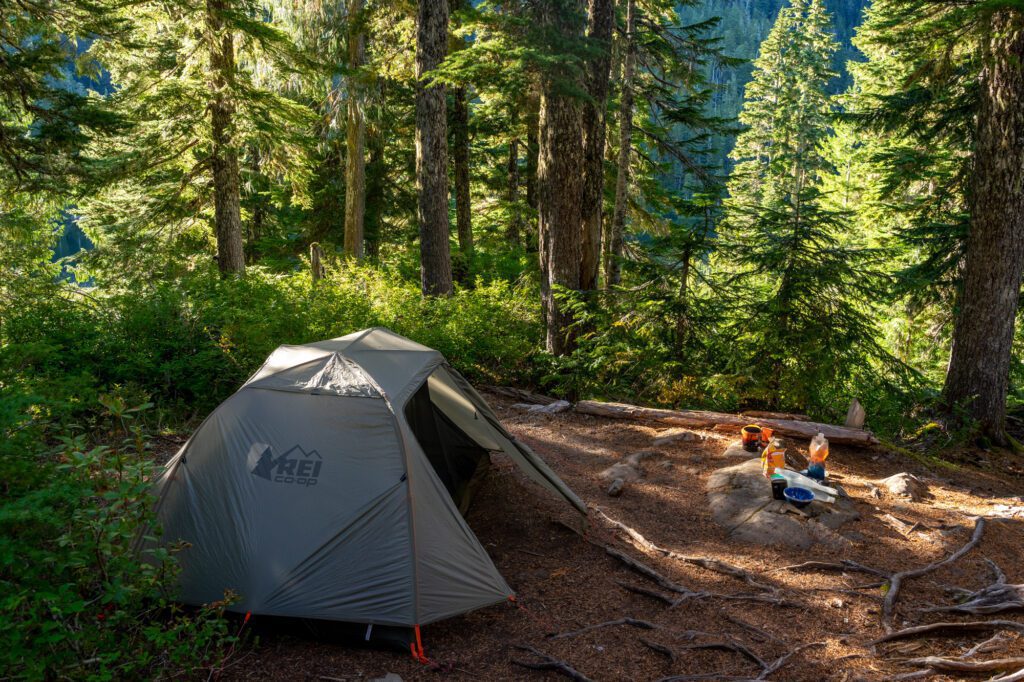
If you’re visiting in the summer or fall and are looking for information on camping in Olympic National Park, we’re going to give you a quick overview here.
Rather than give you a deep dive into the camping situation, we’re going to keep it high-level here and recommend the best campsites. For the details, we’re going to direct you straight to the National Park Service site, which has the most up-to-date information on opening dates and reservation procedures (which have changed a couple of times in the past few years).
At a high level, there are two types of campgrounds in the park – sites that are reservable online in advance, and sites that are first-come, first-served.
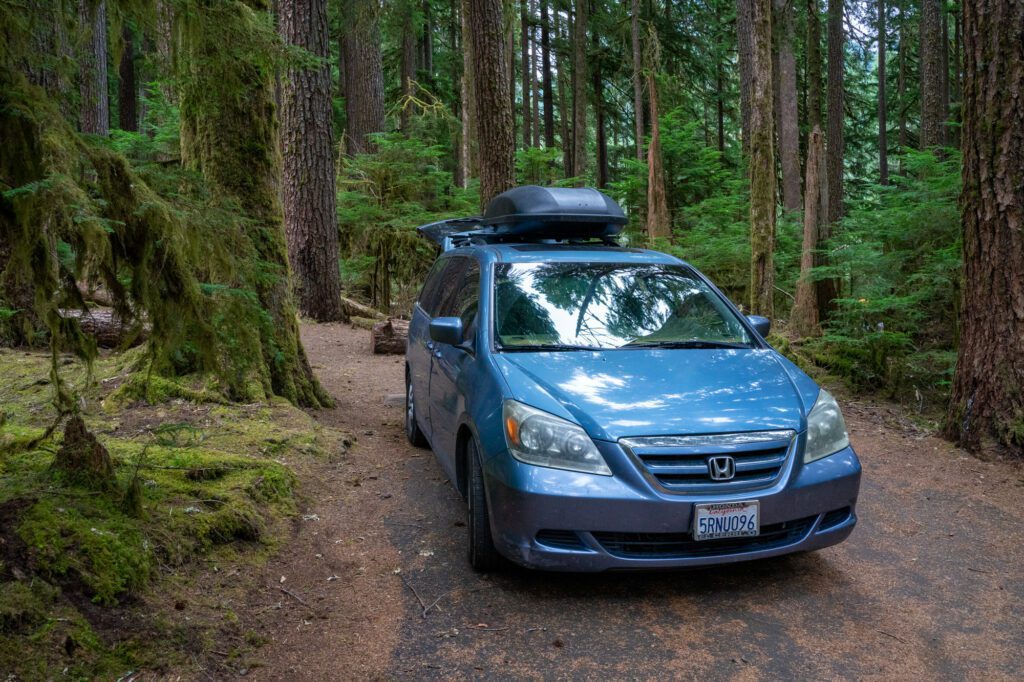
Olympic National Park Campgrounds You Can Reserve in Advance
The campgrounds that you can reserve in advance are:
- Mora Campground (out near Forks and Rialto Beach)
- Sol Duc Campground (near Sol Duc Hot Springs Resort)
- Kalaloch Campground (near the Kalaloch Beaches)
- Fairholme Campground (at Lake Crescent)
- Hoh Campground (in the Hoh Rainforest)
While we just said you can reserve those campgrounds in advance, that’s only true in peak summer season from late May through the month of September. During those months, you’ll need to book in advance.
Availability is released in a somewhat confusing manner. Here’s the information directly from the NPS site (as of early 2023) about Mora Campground.
“Important changes to booking windows: To better serve visitors, Mora Campground will be releasing campsites in a series of three staggered block releases by loop. These block releases will be 6 months in advance, two weeks in advance, and 4 days in advance.
- A, B, and E loop campsites will be available for reservation 6 months in advance.
- C loop campsites will be available for reservations two weeks in advance.
- D loop campsites will be available for reservations 4 days in advance.”
Some version of that is true for all of the campgrounds that you can reserve in advance.
First Come, First Served Campgrounds
All other campgrounds, including Heart O’ the Hills Campground (near Hurricane Ridge) and Ozette Campground (on the north Pacific Coast) are first-come, first-served. That means you will have to show up, find an open site, and pay for it when you arrive.
These campgrounds are competitive, and definitely fill up in the summer months. We would not recommend showing up at 5:00 pm on a summer Friday and expecting to get a site here. All the campgrounds in the park that are first-come, first-served are $25 a night, which you pay on arrival.
You can find more information on camping in the park on the NPS site. You can also check campground statuses here.

Hi! My daughter and I are planning a trip to Olympic Nat’l Park early June 2023. Flying from Chicago to Seattle and renting a car- staying approx 8 days. We love your itinerary- Hurr Ridge, Hoh, Lake Crescent to Lake Quinault. Any recommendations after Lk Quinault or should we make that our last stay before heading back to Sea-Tac airport?
Hey Rhona,
Since you have so much time, I’d recommend making it up to the northwestern corner of the park (Shi Shi Beach and Cape Flattery) while you’re there.
There’s not a whole lot going on between Lake Quinault and Seattle. There are some smaller towns like Aberdeen (where Kurt Cobain is from), and some bigger cities along I-5 like Tacoma and Olympia, but none of those are our favorites.
One other thing you could do is spend a day on Whidbey Island, which we really enjoy. There’s a ferry from Port Townsend (on the northern side of the Olympic Peninsula).
Hope that helps! You’re going to love that particular corner of Washington.
Cheers,
Matt & Alysha
Hi Matt! Thanks for the great article. Is Kalaloch a good alternate option to visit the beaches and rainforest? Planning a trip in July/August 23 and nothing is available in Forks. We will be coming from Port Angeles and then heading to Ashford to explore Mount Rainer.
Hey Niki, Kalaloch is nice, but it really isn’t quite the same as the Hoh Rainforest and La Push beaches. You could totally do a day trip to either of those places from Kalaloch though, which is what we’d recommend in that scenario.